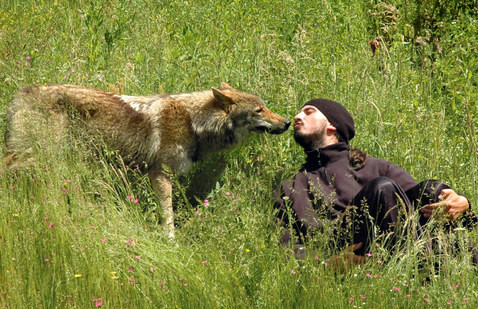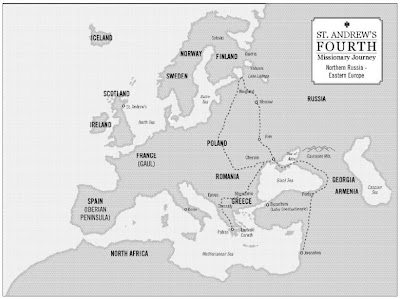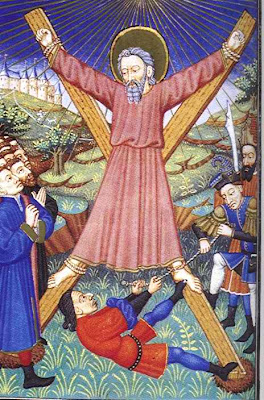
Today is the Feast of St. Andrew, one of the 12 apostles, also known as the first-called.
He was from Bethsaida, never married, and worked with his brother, Peter, as a fisherman. He was a close disciple of St. John the Baptist, so is thought to be an ascetic and a vegetarian. When John said, “Behold, the Lamb of God”, Andrew became Jesus’s first disciple. He then told his brother about Jesus and Peter also became a disciple. He was known to be tall and carried a large staff with a cross carved in it. He had the habit or erecting large stone or iron crosses wherever he went. He did not preach to large crowds like Peter and Paul, but gathered small groups wherever he went. After Pentecost he went on four missionary journeys that let him as far east as China and as far south as Africa. He was the “first-called” but was likely the last of the Twelve to die at around the age of 90 between the years 95 and 105 AD.
 St. Andrew first preached in Judea to the Samaritans and in Gaza. He then went to Lydda in Palestine, to Antioch, and then to Ankara and Edessa, which is today’s Urfa in Turkey. Edessa may have been the first Christian kingdom on earth, perhaps as early as 35 or 36 A.D. After Edessa St. Andrew went to the Greek town of Byzantium (later Constantinople) in 36 A.D. and appointed the first bishop, St. Stachys, who was one of the seventy disciples of the Lord. Then he preached in Bythinia, Cappadocia and Galatia, up through Greek Pontus, which today is northern Turkey. Then he turned to Georgia, Armenia and the Caucuses. This was the first trip, after which he returned to Jerusalem.
St. Andrew first preached in Judea to the Samaritans and in Gaza. He then went to Lydda in Palestine, to Antioch, and then to Ankara and Edessa, which is today’s Urfa in Turkey. Edessa may have been the first Christian kingdom on earth, perhaps as early as 35 or 36 A.D. After Edessa St. Andrew went to the Greek town of Byzantium (later Constantinople) in 36 A.D. and appointed the first bishop, St. Stachys, who was one of the seventy disciples of the Lord. Then he preached in Bythinia, Cappadocia and Galatia, up through Greek Pontus, which today is northern Turkey. Then he turned to Georgia, Armenia and the Caucuses. This was the first trip, after which he returned to Jerusalem.
 His Second missionary journey started off the same, but after getting to Georgia, he passed down to Parthia (Persia) through Kurdistan, and then further on to the Cynocefaloi people in the desert of Gedrozia (now Balochistan) near the coast and the present Pakistan-Iranian border.
His Second missionary journey started off the same, but after getting to Georgia, he passed down to Parthia (Persia) through Kurdistan, and then further on to the Cynocefaloi people in the desert of Gedrozia (now Balochistan) near the coast and the present Pakistan-Iranian border.
This Cynocefaloi bit is pretty fascinating stuff as the name means “the dog head people”. It seems that Alexander the Great and Marco Polo both had run ins with this tribe. George Alexandrou theorizes they were a tribe in the area known to, “Cut their cheeks from mouth to ear, filed the teeth, cropped the ears, and reshaped the skulls of their babies so that they would grow into a very ferocious aspect.” This is also a likely explanation of the Saint Christopher icon who has the head of a dog as he said to have come from this tribe. In the Syriac text of the story it is said that after meeting St. Andrew and converting they were transformed into normal human beings. Alexandrou interprets this to mean that after their baptism they stopped mutilating themselves as that would be against Christian beliefs.
From here St. Andrew went back through Pakistan and Afghanistan following the Silk Road to Sogdiana, now Samarkand and Bokhara in Uzbekistan, not far from the border of western China all the way into Russia. Some of the churches in these areas are dedicated to and named in honor of St. Andrew because of this journey. He then headed back to Jerusalem.
 The Coptic Orthodox tradition tells of a third journey St. Andrew made in Africa. He went somewhere near Ethiopia than headed to the sub-Saharan Africa, between modern Rwanda and Uganda where there was a people known as the Anthropofagi who were cannibals. The description of the people and location appears to describe what we know to be the Bantu people who lived in Mirmadona, “the place where men are food”. While he was there he is said to have defeated a demon named Amayel. After this many of the people became Christians and ceased their demonic practices. Though there is no evidence of St. Andrew being in the sub-Sahara, the people living in the area, when describing demonic entities, call them Amayebe. Also, a guerilla warfare group who believes that they must eat people to receive their power call themselves Amayei-Amayei. St. Andrew would have returned through Ethiopia, then taken the road to Meroe, up the Nile and back to Jerusalem.
The Coptic Orthodox tradition tells of a third journey St. Andrew made in Africa. He went somewhere near Ethiopia than headed to the sub-Saharan Africa, between modern Rwanda and Uganda where there was a people known as the Anthropofagi who were cannibals. The description of the people and location appears to describe what we know to be the Bantu people who lived in Mirmadona, “the place where men are food”. While he was there he is said to have defeated a demon named Amayel. After this many of the people became Christians and ceased their demonic practices. Though there is no evidence of St. Andrew being in the sub-Sahara, the people living in the area, when describing demonic entities, call them Amayebe. Also, a guerilla warfare group who believes that they must eat people to receive their power call themselves Amayei-Amayei. St. Andrew would have returned through Ethiopia, then taken the road to Meroe, up the Nile and back to Jerusalem.
 After the dormition of the Mother of God, St. Andrew began his final journey from Jerusalem. He went back to Pontus, then to Georgia, to the Caucuses, and to the Sea of Azov in southern Russia, on to Donets, and then to the Crimea. At Crimea he established some well known Christian communities. From the Crimea he would have gone up the Dnepr River, a river trade route, to Kiev and to the Scythians of the Ukraine and on to Valaam. He may have traveled from Valaam to Solovki with the Lapp reindeer herders and then to the Baltic Sea. From there he may or may not have gone to Scotland, (he is the Patron Saint of Scotland). He made his way to Poland then on to Romania where he lived for twenty years. He spent most of his time living in a cave at Dervent, Dobrogea in southern Romania. His cave is still honored as a sacred place and many people have gone there on pilgrimage for 2,000 years.
After the dormition of the Mother of God, St. Andrew began his final journey from Jerusalem. He went back to Pontus, then to Georgia, to the Caucuses, and to the Sea of Azov in southern Russia, on to Donets, and then to the Crimea. At Crimea he established some well known Christian communities. From the Crimea he would have gone up the Dnepr River, a river trade route, to Kiev and to the Scythians of the Ukraine and on to Valaam. He may have traveled from Valaam to Solovki with the Lapp reindeer herders and then to the Baltic Sea. From there he may or may not have gone to Scotland, (he is the Patron Saint of Scotland). He made his way to Poland then on to Romania where he lived for twenty years. He spent most of his time living in a cave at Dervent, Dobrogea in southern Romania. His cave is still honored as a sacred place and many people have gone there on pilgrimage for 2,000 years.

George Alexandrou thinks the reason St. Andrew stayed in Romania so long was because he had a great affinity with the Romanian people. They were monotheists, their clerics were like Essenes (celibate and strict vegetarians), and they didn’t keep slaves. They converted to Christianity and considered the previous religion a foreshadow of their new one. It is likely after years of traveling and being unwelcome and beaten in most of those places, the environment in Romania was a welcome retreat. After leaving Romania, he went to Epirus, to Thessaly, to Lamia, to Loutraki-Corinth, then finally to Patras.
 St. Andrew performed many miracles there, even healing Maximilla, wife of the governor of Patra, and his brother Stratokles and many people were added to the faith there. However, the prefect of the city, Aegeatos, wanted nothing to do with the Christian faith, and gave orders to crucify the apostle. St. Andrew was tied to the cross in the shape of an X rather than a T. For two days he continued to teach those who gathered around him. It is said that a large mob marched on Aegeatos’s castle and forced him to order a reprieve, but Andrew would not allow it if Aegeatos was not truly repentant. The crucified apostle, gave glory to God saying: “Lord Jesus Christ, receive my spirit.” A ray of light illumined the cross and when the light faded, St. Andrew had already given up his soul to the Lord. Maximilla, the wife of the prefect, had the body of the saint taken down from the cross, and buried him with honor.
St. Andrew performed many miracles there, even healing Maximilla, wife of the governor of Patra, and his brother Stratokles and many people were added to the faith there. However, the prefect of the city, Aegeatos, wanted nothing to do with the Christian faith, and gave orders to crucify the apostle. St. Andrew was tied to the cross in the shape of an X rather than a T. For two days he continued to teach those who gathered around him. It is said that a large mob marched on Aegeatos’s castle and forced him to order a reprieve, but Andrew would not allow it if Aegeatos was not truly repentant. The crucified apostle, gave glory to God saying: “Lord Jesus Christ, receive my spirit.” A ray of light illumined the cross and when the light faded, St. Andrew had already given up his soul to the Lord. Maximilla, the wife of the prefect, had the body of the saint taken down from the cross, and buried him with honor.
A few centuries later, under the emperor Constantine the Great, the relics of the Apostle Andrew were solemnly transferred to Constantinople and placed in the church of the Holy Apostles beside the relics of the Evangelist Luke and St. Paul’s disciple St. Timothy.
source: ourorthodoxlife.blogspot.ca
Saint Andrew’s Carol
